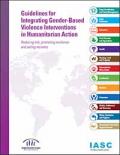Guidelines - Released in 2015
Gender-based violence is among the greatest protection challenges individuals, families and communities face during humanitarian emergencies. Accounts of horrific sexual violence in conflict situations—especially against women and girls—have captured public attention in recent years. These violations and less recognized forms of gender-based violence—intimate partner violence, child marriage and female genital mutilation—are also being committed with disturbing frequency. Natural disasters and other emergencies exacerbate the violence and diminish means of protection. And gender-based violence not only violates and traumatizes its survivors, it also undermines the resilience of their societies, making it harder to recover and rebuild.
Despite the scope and severity of the problem, current programming to prevent gender-based violence and provide support for survivors is insufficient to deliver the desired results. The newly-revised Interagency Standing Committee (IASC) Guidelines for Integrating Gender-Based Violence Interventions in Humanitarian Action: Reducing risk, promoting resilience and aiding recovery are designed to address this gap, with clear steps the humanitarian community can take to protect people from gender-based violence.
Downloads
Organizations
- Inter-Agency Standing Committee (IASC)






